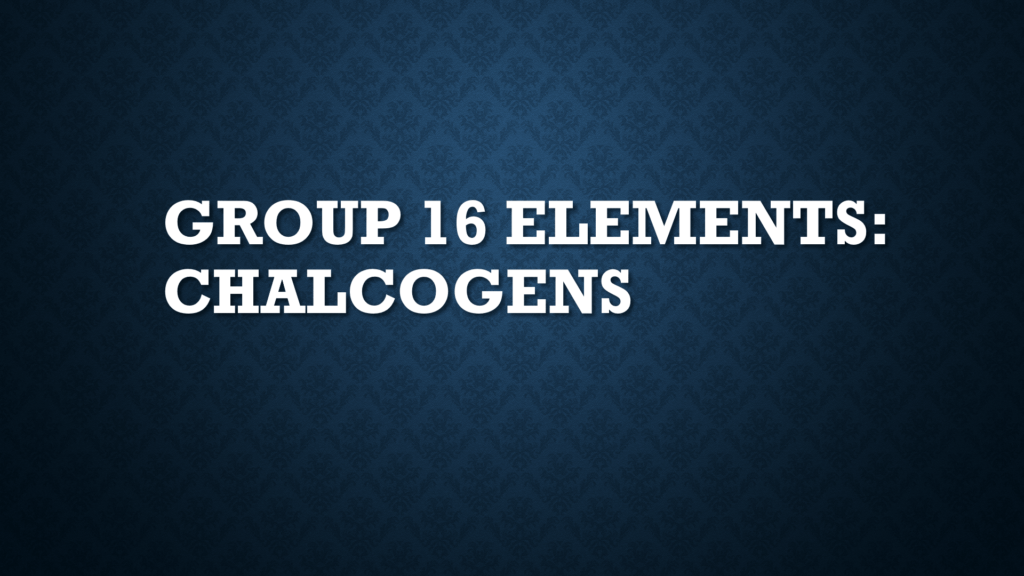The group 16 elements of the modern periodic table consists of 5 elements, namely Oxygen, Sulphur, Selenium, Tellurium, Polonium and Livermorium. The elements of this group are also called Chalcogens or Oxygen Family.

Index
History
Early attempts to separate Oxygen from air were hampered by the fact that air was thought of as a single element up to the 17th and 18th centuries. Oxygen was successfully isolated by Robert Hooke, Mikhail Lomonosov, Ole Borch and Pierre Baydem, but they didn’t realise it at the time.
Later, in 1774, oxygen was discovered by Joseph Priestley, when he focused sunlight on a sample of mercuric oxide and collected the resulting gas. Oxygen was also discovered in 1771 by Carl Wilhelm Scheele, but he didn’t publish the results until 1777.
Sulfur has been around since the ancient times and is mentioned in the Bible 15 times. It was historically used as a component of Greek fire. It was also a key part of alchemical experiments in the Middle Ages. In the 1700s and 1800s, scientists Joseph Louis Gay-Lussac and Louis-Jacques Thenard proved sulfur to be a chemical element.
Tellurium was first discovered in 1783 by scientist Franz Joseph Muller von Reichenstein. Tellurium was discovered in a sample of what is now known as Calaverite.
At first, Muller thought the sample was pure antimony, but the tests that he ran on the sample did not agree on this. He then guessed it to be bismuth sulfide, but he was wrong again.
Muller pondered on the problem for some years, and eventually on realising the sample was gold bonded with an unknown element, he sent it to German chemist Martin Klaproth. Klaproth purified the undiscovered element, and named it tellurium.
Selenium was discovered in 1817 by Jons Jacob Berzelius. Berzelius, he first noticed a reddish-brown sediment at a sulfuric acid manufacturing plant. The sample was thought to contain arsenic. Berzelius thought the sediment contained tellurium but soon realised that it also contained a new element which he named selenium.
Polonium was discovered by Marie Curie and Pierre Curie. In the late 19th century, the two scientists discovered that a sample of pitchblende was emitting four times as much radioactivity as that of uranium alone. The Curies gathered several tons of pitchblende and refined it for several months until they had a pure sample of polonium. IT was officially discovered in 1898.
The first attempt to create Livermorium was from 1976 to 1977, at the Lawrence Berkeley National Laboratory, who bombarded curium-248 with calcium-48, but were not successful. After several failed attempts livermorium was created in 2000 at the Joint Institute for Nuclear Research, using the same process.
The Group 16 Elements or Chalcogens
The group 16 elements are called chalcogens because most ores of copper are oxides, sulphides and such ores contain traces of selenium and tellurium. They are also called the oxygen family.
| Property | Oxygen | Sulfur | Tellurium | Selenium | Polonium | Livermorium |
| Atomic Symbol | O | S | Se | Te | Po | Lv |
| Atomic Number | 8 | 16 | 34 | 52 | 84 | 116 |
| Atomic Mass(amu) | 16.00 | 32.07 | 78.96 | 127.60 | 209 | 292 |
| Valence Electronic Configuration | [He] 2s22p4 | [Ne] 3s23p4 | [Ar] 3d104s24p4 | [Kr] 4d105s25p4 | [Xe] 4f145d106s26p4 | [Rn] 5f14 6d10 7s2 7p4 |
| Atomic Radii(pm) | 48 | 88 | 103 | 123 | 135 | 183 |
| Melting Point/Boiling Point(OC) | -219/-183 | 115/445 | 221/685 | 450/988 | 254/962 | 364/762 |
| Density(g cm-3) | 0.00143 | 2.07 | 4.3 | 6.24 | 9.2 | 12.9 |
| First Ionization Energy/kJ mol-1 | 1314 | 1000 | 941 | 869 | 812 | 663.9 |
| Common Oxidation State(s) | -2 | +6, +4, -2 | +6, +4, -2 | +6, +4, -2 | +2, +4 | -2, +2, +4 |
| Electronegativity | 3.4 | 2.6 | 2.6 | 2.1 | 2.0 |
The anomalous behaviour of oxygen, like other members of p-block present in second period is due to its small size and high electronegativity. One typical example of effects of small size and high electronegativity is the presence of strong hydrogen bonding in H2O which is not found in H2S.
Why does polonium have a lower melting and boiling points?
The outer electron configuration of Polonium could differ so much from its lighter family member tellurium due to the electron constriction, causing an outer electron to fall into a lower shell, that the intramolecular forces are weaker. Thus a lower boiling point.
Trends in Group 16 Elements
- Electronic Configuration
- The valence shell configuration of group 16 elements is ns2, np4.
- Atomic Radii
- Going down the group, the atomic radii increases.
- Ionisation Enthalpies
- As the radius of the atom increases, the ionisation enthalpy decreases.
- Electronegativity
- Electronegativity decreases while progressing down the group due to the increase in radius and the increase in the electron-electron repulsion.
- Metallic Nature
- Oxygen and sulfur are non-metals.
- Selenium and tellurium are metalloids.
- Melting and Boiling Points
- Due to increase in atomic sizes, the melting and boiling point increase, while progressing down the group.
Applications
- Oxygen is used in steelmaking, chemical industry water treatment, medical use, rocket fuel and metal cutting.
- Sulfur is used in the chemical industry and sulfuric acid.
- Sulfur is also used in Greek fire, gunpowder, concrete, fireworks, etc.
- Selenium is used in glassmaking, agriculture, photovoltaic materials, etc.
- Tellurium, in the form of tellurium suboxide, is used in the rewritable data layer of some CD-RW and DVD-RW disks.
- Cadmium telluride is a high-efficiency material in solar panels.
- Polonium is used as an alpha-particle generator for research.
- It is also used in nuclear batteries, antistatic devices.
- Applications for livermorium have not been discovered yet.
More on P Block
